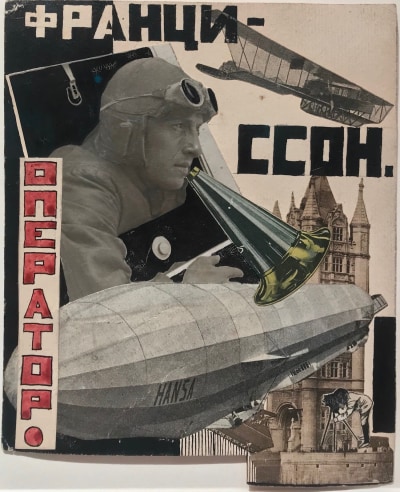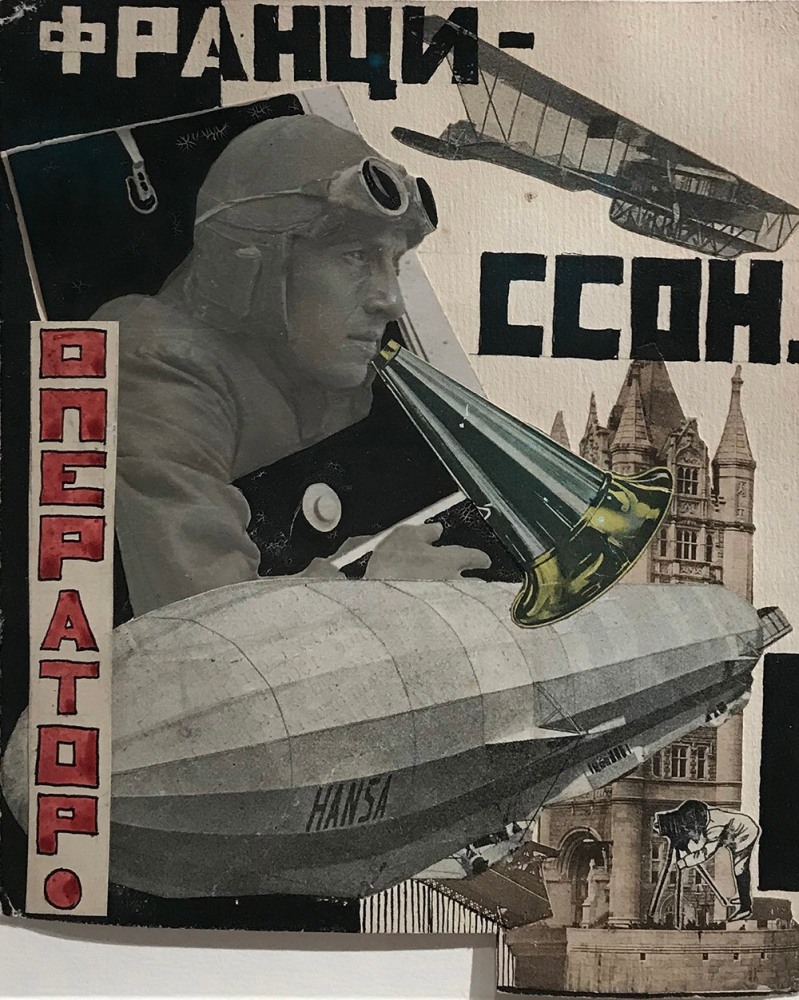

Petr Stepanovic Galadzhev (1900-1971)
Maquette for the Front Cover of Dreams (Operator Frantsisson), c. 1920s
Photocollage on board with handdrawn lettering
6 1/2 x 5 3/8 in. (16.5 x 13.7 cm)
This photomontage celebrates Soviet cinematographer Boris Frantsisson (1899-1960), who took some of the first aerial shots of Moscow in the early 1920s. Part of the milieu of Soviet Constructivist filmmakers and photographers, Frantsisson was cinematographer for Sergei Eisenstein’s first film, Glumov’s Diary (1923), and collaborated with the director Dziga Vertov on films like Girl with a Hatbox (1927), and The Happy Canary (1929). Galadzhev has inscribed the words “Frantsi-" and "sson” on the collage, perhaps intended as a pun on the Russian word “son,” meaning to dream. Galadzhev’s wordplay reflects the ideals of flight and technology that captivated members of Moscow’s bourgeoning film scene in the 1920s.
See Cavendish, Philip, The Men with the Movie Camera: the Poetics of Visual Style in Soviet Avant-Garde Cinema of the 1920s. New York: Berghahn Books, 2016, p. 21


In celebration of the fifteenth anniversary of the opening of Nailya Alexander Gallery, we are pleased to announce two exhibitions: Masters of Early 20th-Century Soviet Photography, on view from Wednesday 27 March to Saturday 11 May, followed by a group exhibition of the gallery’s contemporary artists, on view from Wednesday 15 May to Friday 12 July 2019.
Nailya Alexander Gallery was founded in New York in 2004 after several years of private work in Washington, D.C. For the past decade and a half, the gallery has prided itself on its diverse roster of contemporary fine-art photographers as well as on its collection of rare and vintage gelatin-silver prints by the great pioneers of the Russian avant-garde.
Masters of Early 20th-Century Soviet Photography presents a rare selection of vintage gelatin-silver prints from the latter group, including work by such luminaries as Boris Ignatovich (1899-1976), Aleksandr Rodchenko (1891-1956), Arkady Shaikhet (1898-1959), and Georgy Petrusov (1903-1971). These artists reached the zenith of their careers immediately after the 1917 Russian Revolution, during a historic moment of creative freedom and development. They left an indelible mark on the history of their medium, introducing to photography fresh perspectives and experimental forms that reflected the radical changes transforming the world around them.
On view are not only some of the most iconic photographs of the era, but some of the highest-quality printmaking, whereby meticulous attention to light, tone, and texture has transformed each image into a unique and exquisite object of art. These include images both of and by the great artists of the period: a vintage gelatin silver print of one of Aleksandr
Rodchenko’s earliest photographs, Portrait of Vladimir Mayakovsky (1924), captures the enigmatic poet who famously commanded his audience in 1917 to “throw Pushkin, Dostoevsky, Tolstoy, etc., etc., overboard from the Ship of Modernity”; and perhaps the only existing exhibition-size photograph of Sergei Eisenstein shows the filmmaker relaxing on the throne of Tsar Nicholas II during the production of October (1928). As scholar Marie Seton writes, “With the mock gesture of His Majesty waving his hand, [Eisenstein] ordered photographs to be taken of himself in his role of iconoclastic emperor of a new art form.” The photographers Boris Kudoyarov and Dmitry Debabov are caricatured in Georgy Petrusov’s 1934 portraits, which reveal not only a playful sense of humor but a shared spirit of innovation and irreverence.
Other photographs depict the revolution in industry, architecture, and labor that was sweeping the nation, such as Arkady Shaikhet’s Construction of the Globe at the Moscow Telegraph (1928), which El Lissitzky superimposed onto the body of a factory worker in a photocollage created for the International Hygiene Exhibition Soviet pavilion in Dresden in 1930. Georgy Petrusov’s Lunch in the Fields and Harvest (1934) illustrate daily life and labor on the newly developing collective farms. The exhibition also includes two extraordinary vintage gelatin-silver prints by the great master Boris Ignatovich. Youth (1937) celebrates the joy and energy of early adolescence with a close-up, triangular composition perfectly corresponding to the rounded shape of the camera lens; while Motherhood (1938) is both poignant and daring due to its creation during the time of the Stalinist purges.